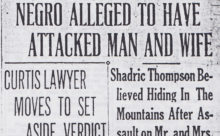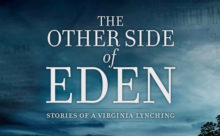Other Side of Eden review: Educational Media Online
Review in Educational Media Online by Timothy Hackman, University of Maryland.
click for Academic Library Orders.
***
The Other Side of Eden: Stories of a Virginia Lynching tells the story of Shedrick Thompson, a black farmhand whose decomposing body was found hanging from a tree in Fauquier County, Virginia, in September 1932. Thompson, known as Shed to his friends and family, worked for a white family by the name of Baxley, along with his wife, Ruth. A crowd formed around Thompson’s violated body and, bizarrely, decided to set it ablaze. Even more unbelievably, a grand jury ruled Thompson’s death a suicide. The county coroner set the probable date of death at July 20, 1932, and Thompson’s remains were kept beneath the steps of the county courthouse in Warrenton, Virginia, before they eventually disappeared.
The Other Side of Eden is based on the book, The Last Lynching in Northern Virginia: Seeking Truth at Rattlesnake Mountain, by Jim Hall (The History Press, 2016). Hall, who appears in the film along with researcher and associate producer Shawn Nicholls, is a retired newspaper reporter and editor who lives in Fredericksburg, Virginia. By digging through primary sources and interviewing Fauquier County residents, Hall uncovers the events leading up to Thompson’s death and proves that it was indeed a lynching. The fact that it occurred four years after Virginia’s Anti Lynching Law of 1928 (the first to specifically define lynching as a state crime), makes it unique and of interest to Virginia historians and those who study the history of civil rights in America.
The film uses interviews with residents in and around Fauquier County, many filmed at locations associated with Thompson’s life and death. Most of the interviewees had family members alive at the time of the lynching and have inherited both stories and photos; a few of the interviewees were alive in 1932, although none of them experienced the lynching firsthand. The filmmaker takes the Rashomon-like approach of having these sources tell their version or piece of the story as they have heard it, allowing them to overlap or even contradict each other. The result can be confusing and difficult to follow, particularly in the beginning when the film dives directly into the story with no prologue or exposition. By the end, however, the effect mimics the process of historiography itself. The small pieces begin to fit together and eventually form a complete picture of what happened and why.
The central mystery of the story is why Thompson attacked the well-liked, wealthy, white couple for whom he and his wife worked. On the night of July 17, 1932, Thompson entered the Baxley home, beat Henry Baxley, stole two pieces of jewelry, and abducted and raped Mamie (Maxfield Yates) Baxley. A warrant was quickly sworn out for Thompson’s arrest, and he fled the county while hundreds of Fauquier County residents scoured the area for him. A six-man posse, including an ancestor of Daniel Heath de Butts, who is interviewed for the film, caught up with Thompson when he made the unwise decision to return to the county. The film (and its brief epilogue, also included on the DVD) follows the evidence and comes to a conclusion about Thompson’s motivations for his attack on the Baxleys, which this review will not spoil.
The film succeeds in painting a picture of the county in the early part of the twentieth century – the one room schoolhouse, the hilltop known as “Little Africa” due to its population of sixty black families, the story of black housekeeper who died of appendicitis after being refused treatment by a white hospital, the resurgence of the Ku Klux Klan in Northern Virginia during that time, the prevalence of lynching.
The story it tells is compelling. It is recommended viewing for those with an interest in seeing how oral history, primary documents, and good, old-fashioned research can come together to uncover a mystery nearly 90 years old.
Recommended for comprehensive collections on the legacy of slavery, Virginia history, African American history and civil rights, and the sad history of lynching in America

